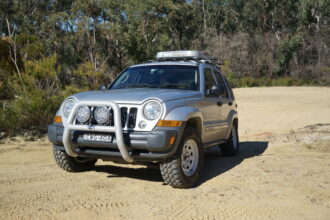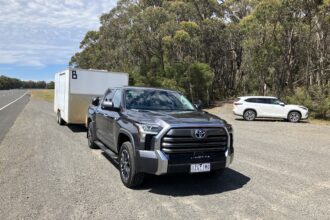Could the new JL Wrangler be the best Wrangler Jeep has ever built?
SO WHAT IS IT?
The Jeep Wrangler is built for seriously technical off-road terrain, offering more capability than most people will ever require. For those just cruising down your usual Outback tracks, the Wrangler is like bringing a gun to a knife fight; opt for the Rubicon and it’s like showing up with a fighter jet… overkill, and maybe not that useful.
The Wrangler is, and always has been, the easiest way to drive out of the showroom and get into technical four-wheeling. It offers enough capability to soak up the majority of novice off-road mistakes, while still giving enthusiasts the equipment they need to take it to a completely different level.
INSIDE
We’re not saying that the last-generation Wrangler JK was a terrible place to be, but the new JL certainly raises the bar to a higher level. Additions such as interchangeable aluminium fascias are easy to wipe down (while still looking tops), and the burled aluminium knobs throughout the vehicle’s climate and entertainment controls add a nice high-end touchpoint.
We noted the new dash is decidedly vertical and square, compared to the last model’s propensity for rounded corners. And for the first time ever, you’re able to get that dash in leather – though we’re not sure how that’s going to deal with being baked by the Aussie sun. After all, Detroit is known more for its muscle cars than its constant sunshine.
There’s nothing like cruising in a Wrangler with the top down and the doors off, but our biggest gripe comes with the cramped feeling that the cab has – particularly if you’re tall. With the seat pushed back, my head was touching the roll bar. I had to keep the seat forward to fit (I’m 190cm tall, for reference).
OUTSIDE
In a world of re-bodied, shared-platform SUVs, and a boring corporate mentality that loves the efficient profits they bring in, Mark Allen (head of Jeep design) has become a bit of a gatekeeper for the Wrangler. He’s taken it upon himself to ensure that the DNA of the vehicle – which dates all the way back to World War 2 – is still present in the modern-day version.
You’ll notice a more prominent flat hood, reminiscent of the older CJ-models, lacking the slope of the previous model which Allen commented always annoyed him. Keen Jeep enthusiasts will also notice the aerodynamic kink on the grille looks much like the one on the YJ-models; and it continues onto the windshield that’s more slanted than ever before. But don’t worry… it still folds down and it’s even easier to do that now (in just under five minutes).
Details like the Wrangler JL Rubicon’s ability to fit aftermarket 35-inch tires without modification, and the ability for the hood latches to secure a winch remote cable, show that Mr Allen still has the back of the enthusiast and that a big massive corporation is still paying attention.
ON-ROAD
Car magazines used to reviewing the latest BMW or Audi will likely tell you that the Wrangler does not handle well, that the steering is vague, and that the cabin is uncomfortable. We will tell you that the Wrangler JL improves upon its predecessor, the JK, in every regard. It is more refined, more powerful and more capable than any Wrangler to date. The 3.6L petrol engine we drove is now in its second generation, and while it doesn’t see any power gains the 8-speed automatic transmission really does wake the engine up.
Electric-assisted hydraulic power steering gives the Wrangler a better feel on the road, and the swept-back windshield makes for a quieter ride inside the cabin. The use of aluminum in the doors, hood and rear tire gate, when combined with the use of high-strength steel in the frame, shed 90kg off of the four-door vehicle… which makes the driving experience lighter and more effortless.
OFF-ROAD
You buy a Wrangler for the ability to drive technical terrain, and that’s where it excels. The rock course where they allowed us to test the vehicle’s limits was filled with steep vertical waterfalls and loose rock. Too unpredictable for almost any other stock vehicle – but if we’re being honest, the Wrangler wasn’t even at its limit.
The suspension is more flexible than a Yoga guru, and the increased crawl ratio of 84.2:1 allowed for unprecedented control and room to grow as you inevitably modify the vehicle. On rutted roads, we found the suspension to be compliant; aided by the addition of rubber dampeners on top of each of the four coil springs.
Considering it’s a Wrangler, there will no doubt be heaps of aftermarket modifications available to take it from mild to wild in next to no time. But we’re also keen to see the addition of MOPAR’s extensive OEM aftermarket options – snorkels, bumpers and factory-engineered lift kits will be available.
FOR THE 4WD TOURER
The Wrangler has never really caught on with the 4X4 touring crowd, and unfortunately this generation isn’t going to get any better in that department. The interior still remains cramped, and rear storage hasn’t increased by a significant margin. An esky is still going to take up almost half of the rear cargo space, and a roof rack (despite the addition of reinforced rain gutters) will still require drilling through the hard top. But for those looking to tackle the toughest tracks with lightweight camping gear, you’ll find no vehicle more capable.









